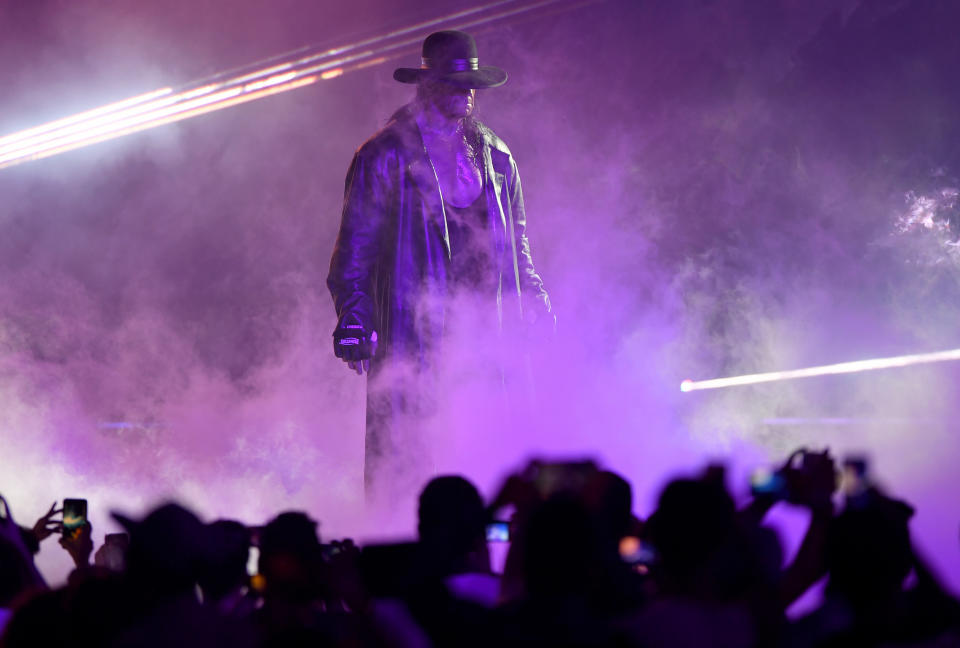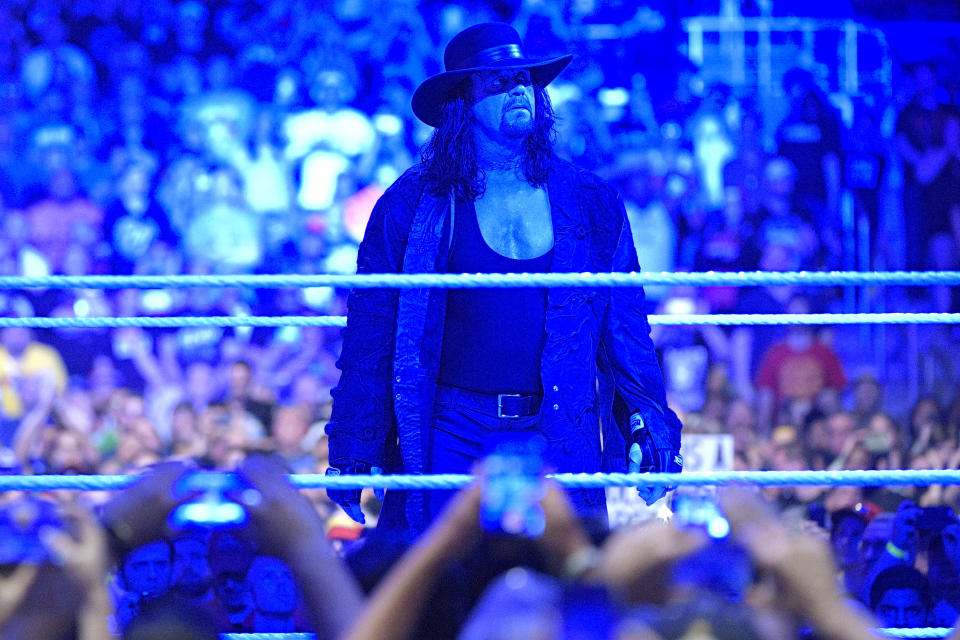'I wish I could do it forever': The Undertaker prepares his WWE farewell

Thirty years ago, a 25-year-old Mark Calaway was in the midst of a somewhat normal career change as a professional wrestler. Calaway, who had just finished a run with World Championship Wrestling as “Mean Mark Callous,” had been let go by Ted Turner’s promotion and was getting set to debut in Vince McMahon’s WWF.
Calaway’s debut came on Nov. 22, 1990, at “Survivor Series,” and what transpired over the next three decades not only cemented his legacy in professional wrestling, but also helped turned WWE into the standard-bearer for an entire industry.
“I don’t think in our industry, these kinds of careers don’t happen often,” Calaway told Yahoo Sports. “It was kind of hard to imagine going for 30 straight years with one company. You don’t envision that when you first start out. You hope you can catch on a little bit, have a run, build momentum where if you have to go somewhere else, like Japan or another promotion you are in good shape. I never planned on going back to WCW once I got to WWE, but I knew Japan and other places, I could have built a strong name and maybe go back and forth.”
‘Here I am trying to be this killer ... and the crowd is leaning toward you’
Calaway would never have to worry about going back and forth between any companies for the next 30 years, as his Undertaker character would catch on immediately with fans, creating something of a Sam Bowie moment for Turner and WCW.
Just a year later, at the very same event Calaway debuted at, the 6-foot-10 wrestler found himself in the ring with Hulk Hogan, the WWF world champion and arguably the most influential figure the industry had seen until that point.
To top it all off, Calaway wasn’t simply going to be wrestling Hogan, he was going to be going over and winning the top title in the company, too.
“That was a fast year. It all happened really fast and then I got the word at Survivor Series, my one-year anniversary, that I am going to be wrestling the golden goose and I’m going to be world champion,” Calaway said. “It was amazing. A year into this thing, I’m still looking at myself kind of as a greenhorn. That’s how it was back then. I had only been in the business for about four years and here I am, wrestling one of the biggest legends our industry has ever seen and I’m going over. It was really surreal.”
As if wrestling Hogan as a 26-year-old wasn’t a big enough deal, Calaway’s Undertaker character had become such a phenomenon at that point that even the “Immortal” Hulk Hogan couldn’t sway fans away from the captivating big man.
“You’re nervous, then when you do the walkout that night it threw me off because it was like 60-40 the crowd was behind me,” Calaway said. “I was the babyface. Here I am trying to be this killer, this scary dude, and you come out and the crowd is leaning toward you. You have to put that out of your mind so you can do business and be what you’re supposed to be, but it was amazing.”
Undertaker and WWE’s supernatural recipe for success
While WWE, both then and now, will often tinker with characters and switch them between babyface (hero) and heel (villain), Calaway’s Undertaker character has been impervious to these changes. Apart from a stint as the “American Bad Ass,” Calaway has played the same character on WWE programming dating back to the Bush administration — the first one.
As impressive as Calaway’s ability to get — and stay — over with fans for three decades is, perhaps the defining moment of his career came in 1997, in the midst of WWE’s “Monday Night War” with WCW.
Although most will immediately bring up “Stone Cold” Steve Austin and Dwayne “The Rock” Johnson when reminiscing about WWE’s “Attitude Era,” Calaway began arguably the greatest storyline in professional wrestling history alongside Glenn Jacobs and the late William Moody — better known as Kane and Paul Bearer.
The trio created a storyline that leaned far more into the entertainment aspect of the business and, in turn, created a believable foil for Calaway. As the brotherly saga of the Undertaker and Kane played out on a weekly basis, fans were allowed to suspend disbelief in a way that delivered a perfect counter-programming punch to what they were seeing in WCW and other aspects of WWE.
“Although I had wrestled some giants up until that point and I had these dragons that I had to slay, none of them really matched up like Kane did,” Calaway said. “You have this over-the-top character in the Undertaker, but now he has a brother? It was over the top, but there was a real kind of connection that people could identify with. If you have a sibling, you understand sibling rivalries, but now it’s on an entirely different scale. You have one who throws lightning and the other creates fire. It was part reality, part supernatural, almost comic book story. I will always say it is the best story that WWE has ever told.”
‘I wish I could do it forever’
Now 55, Calaway will be the first to tell you he isn’t the same Undertaker he was back then. Although fans will immediately associate Undertaker’s character with “WrestleMania” — where his annual performances often overshadowed the card’s main event — “Survivor Series” is just as symbolic for the legendary character.
Being billed as Undertaker’s “Final Farewell,” Calaway will seemingly say goodbye to WWE — 30 years to the day from his debut with the company. In the lead up to the event, WWE and Calaway have pulled back the curtain on the Undertaker via both the “The Last Ride” docuseries and several specials that have aired on the WWE Network. These marked the first time fans have been allowed to see the notoriously private Calaway opposed to the character he plays on television.
“I think a lot of people saw this invincible character and what this year has done is given an air of vulnerability to me,” Calaway said. “It really wasn’t my original goal, but I do think it encapsulates how important it was for me to be the Undertaker for our fans. From the time that we start the doc, I think it shows what it took me physically to go out and honor that. That was the gist of where we took the story, how important it was for me to go out and perform and it was a natural segway into the person.”
Calaway has attempted to walk away from the business before, most notably in 2017 when he left his gear in the center of the ring after losing to Roman Reigns at “WrestleMania 33.” Despite the symbolic gesture, Calaway has performed several more times over the past three years, including in a widely acclaimed Boneyard Match at “WrestleMania” this past April against A.J. Styles. The cinematic nature of the match, spawned from necessity during the global coronavirus pandemic, seemingly left the door open for Calaway to continue his career for a few more years.

“I still have the passion to do it, I wish I could do it forever,” Calaway said. “When I watch the shows or I’m there live, the juices start flowing and I feel like I have to get ready to go out and perform. The reality of the situation is that I’m not physically able to perform at the level I want to perform at. I could go out there and cash in on all of the equity I’ve built up over 30 years, but I can’t deliver physically what I think people pay money to see the Undertaker do.”
While many believed the Boneyard Match would have extended Calaway’s career, the ironic part is that WWE not having fans physically in the arena might actually make it easier for Calaway to say goodbye for good. In pro wrestling, performers make their living by getting fans to react to them, good or bad. In turn, that reaction gives wrestlers something akin to an adrenaline rush, or a high that many find difficult to ever truly walk away from.
As Calaway bids farewell, instead of staring into a sea of physical fans, he’ll be talking to LED screens showing fans watching remotely from the comfort of their home.
“It’s going to help me considerably, getting through Survivor Series emotionally,” Calaway said. “I’m sure it’s going to be moving and it’s going to have its moments, but it would have been extremely hard for me to come out in front of an arena full of people and address them in any way at this point. I made fun of Flair for boo hooing and crying when he came out and did his speech. I think I have a little more of an appreciation now as it faces me. Hopefully, I’ll be able to keep it together and not kill off the gimmick completely.”
Gimmick or not, Calaway’s influence and mark on the industry as the Undertaker cannot truly be overstated. It’ll remain to be seen if he will be able to fully retire from in-ring action (he will readily do a McMahon impression, ‘Never say never’), but as he walks back through the curtain on Sunday, there’s one final thing he wants fans to know.
“No matter what was going on in my life, I just want people to understand that I took the responsibility of being that character and bringing that character every week seriously. Maybe there are some in my life that would say I took it too seriously and damaged relationships and wasn’t there,” Calaway said.
“But I know that people were paying hard-earned money and a lot of times were having to scratch and claw to bring their kids to wrestling. I never took that for granted. I hope people understand and appreciate that.”
“Survivor Series” airs Sunday, November 22nd at 7pm ET on the WWE Network
More from Yahoo Sports:
